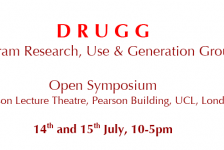D R U G G
(Diagram Research, Use & Generation Group)
Open Symposium
Pearson Lecture Theatre, Pearson Building, UCL, London
14th and 15th July, 10-5pm
Diagrams are found in a variety of creative fields and academic disciplines where they
serve different functions. However diagrammatic practices share a number of generic
characteristics that include the representation of concepts, forces and relations, the
storage and organisation of data and the generation of new worlds.
What counts as a diagram? Diagrams are not just graphic figures and words on paper,
they are also cognitive machines traversed and activated by discourse. In this sense
diagrams involve or generate narration, interpretation and performance and are not
limited to two dimensions. They are experiments in thinking that have the potential to
engender new discourses and relations between diverse artistic, philosophical and
scientific fields.
This two-day research event will address a range of diagrammatic issues through
presentations, papers, demonstrations, workshops, drawings, film and performance.
We have several confirmed speakers and several additional, twenty minute time-slots
for guest presentations. We are inviting proposals from those wishing to contribute
further papers. Please send details of your title and a one-sentence description to
jcussans@gmail.com. Due to limited remaining slots you will be notified if you have
been selected by 11th July.
Confirmed Speakers
Ami Clarke Error-correction- an introduction to future diagrams.
Andrew Conio Diagram without an Image – Diagrams exist in the world, they are the
invisible armatures that figure the palpable and haptic yet indiscernible modulations
that exist between forces (which may be material, virtual, ideational or social). The
Diagram can also serve as a concept for understanding the status, meaning, and
function of artistic activity. I will examine whether the ‘diagram without image’ can be
used to explore how political (strategic interventionist) artworks can be conceived
outside of the conventions of art history and theory?
John Cussans Diagram-as-Thinking-Machine/Art-as-Metapractice – a demonstration of
Alfred Korzybski’s 4-dimensional diagram (or ‘Structural Differential’) exploring the
idea of art-as-metapractice.
Dean Kenning Diagram and allegory: how drawing thinks – Utilising my ongoing work
Metallurgy of the Subject, I will demonstrate the way the diagrammatic and the
allegorical work in conjunction, each arising from the spaces and gaps created by the
other in a single work, simultaneously clarifying and complicating, condensing and
proliferating, representing and producing connections, positions and meanings.
David Osbaldeston poses the question, ‘if an artists purpose is to lie, then why the hell
am i drawing a diagram to explain it?’ He will aim to explore how forces of
obfuscation, miscommunication, and displacement of language may apply to
reconsider our perceived relations with the world, past, present, or future, as anything
but axiomatic.
Matt Rodda Diagramming the Phantasm – This talk explores the importance of diagrams
in visualising the theory of the phantasm. In particular, the presentation utilises a
diagramming of phantasmatic models (notably following Giorgio Agamben) to make the
not easily observable empirical phenomena of the phantasm perceivable.
Fatos Ustek The Tricothomy of Now : A Sheer Speculation – Illustration of forward
and backward causation on juxtaposed coordinates of two now-planes.
The event is free, and all are welcome, but please confirm attendance to d.burrows@ucl.ac.uk
Venue:
Pearson Lecture Theatre, Pearson Building, UCL, Gower Street, London, WC1E 6BT
The Lecture Theatre is on the left side and in the left hand corner of the Quad of
Gower Street, entrance to Pearson Building is to the left of the Slade.
Map of UCL campus. http://www.ucl.ac.uk/locations/ucl-maps
DRUGG facilitators: Dave Burrows, Ami Clarke, Andrew Conio, John Cussans, Dean
Kenning, David Osbaldeston

